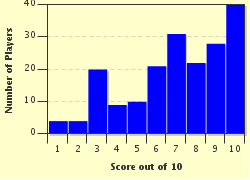Quiz Answer Key and Fun Facts
1. Consider the White pawn on e4. Which piece may it capture? Black's pieces are situated as follows: knight on f5, pawn on e5, rook on c6 and the Black king is on e7.
2. After the following moves: 1.e4 f5 2.e5 d5, which pawn may be captured by White? (Hint: consider "en passant.")
3. The Ruy Lopez is one of the most popular and well analyzed openings in chess. One variation goes as follows: 1.e4 e5 2.Nf3 Nc6 3.Bb5 d6. Which piece may White's bishop now capture?
4. Grob's Attack is an unusual opening and begins as follows: 1.g4 e5 2.g5?. White has made an error. Which Black piece may now capture the pawn on g5?
5. In this brief example, White opens with 1.Nf3. Black replies with 1. ... e5. With which piece may White capture the pawn on e5?
6. In the Bishop's Opening, the following moves are played: 1.e4 e5 2.Bc4 Nf6 3.Nc3 ... Which of White's pieces is vulnerable to capture?
7. In this position, we have for White, a king on e3, a rook on g2 and a knight on d3. For Black, there is a king on e6, a rook on c3 and a bishop on e5. It's White to move. Is it possible for White's knight to capture Black's bishop on e5?
8. This position involves the rules of castling. Here are the moves: 1.e4 e5 2.f4 exf4 3.Nf3 Nc6 4.Bc4 Bc5. Now, is it legal for White to castle in this position?
9. Here is an example of a very irregular opening, yet plausible: 1.h4 g6 2.h5 Bg7 3.hxg6 hxg6. Which piece may White's rook capture?
10. Here is an example from the Pirc Opening, Austrian Attack: 1.e4 d6 2.d4 Nf6 3.Nc3 g6 4.f4 Bg7 5.Nf3 c5 6.dxc5 Qa5 7.cxd6. Which piece can Black's knight on f6 capture?
Source: Author
christopherm
This quiz was reviewed by FunTrivia editor
WesleyCrusher before going online.
Any errors found in FunTrivia content are routinely corrected through our feedback system.

